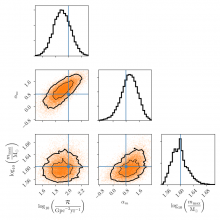
Abstract
Gravitational wave measurements will provide insight into the population of coalescing compact binaries throughout the universe. We describe and demonstrate a flexible parametric method to infer the event rate as a function of compact binary parameters, accounting for Poisson error and selection biases. Using concrete synthetic data based on projections for LIGO and Virgo's O3 run, we discuss how well GW measurements could constrain the mass and spin distribution of coalescing neutron stars and black holes in the near future, within the context of several phenomenological models described in this work. We demonstrate that only a few tens of events can enable astrophysically significant constraints on the spin magnitude and orientation distribution of BHs in merging binaries. We discuss how astrophysical priors or other measurements can inform the interpretation of future measurements. Using publicly-available results, we estimate the event rate versus mass for binary black holes. To connect to previously-published work, we provide estimates including reported O2 BBH candidates, making several unwarranted but simplifying assumptions for the sensitivity of the network and compleness of the reported set of events. Consistent with prior work, we find BHs in binaries likely have low natal spin. With available results and a population favoring low spin, we can't presently constrain the typical misalignments of the binary black hole population. All of the tools described in this work are publicly available and ready-to-use to interpret real or synthetic LIGO data, and to synthesize projected data from future observing runs.